Aquarium of the Pacific: Project Coastal Crisis
- Sustainable Development
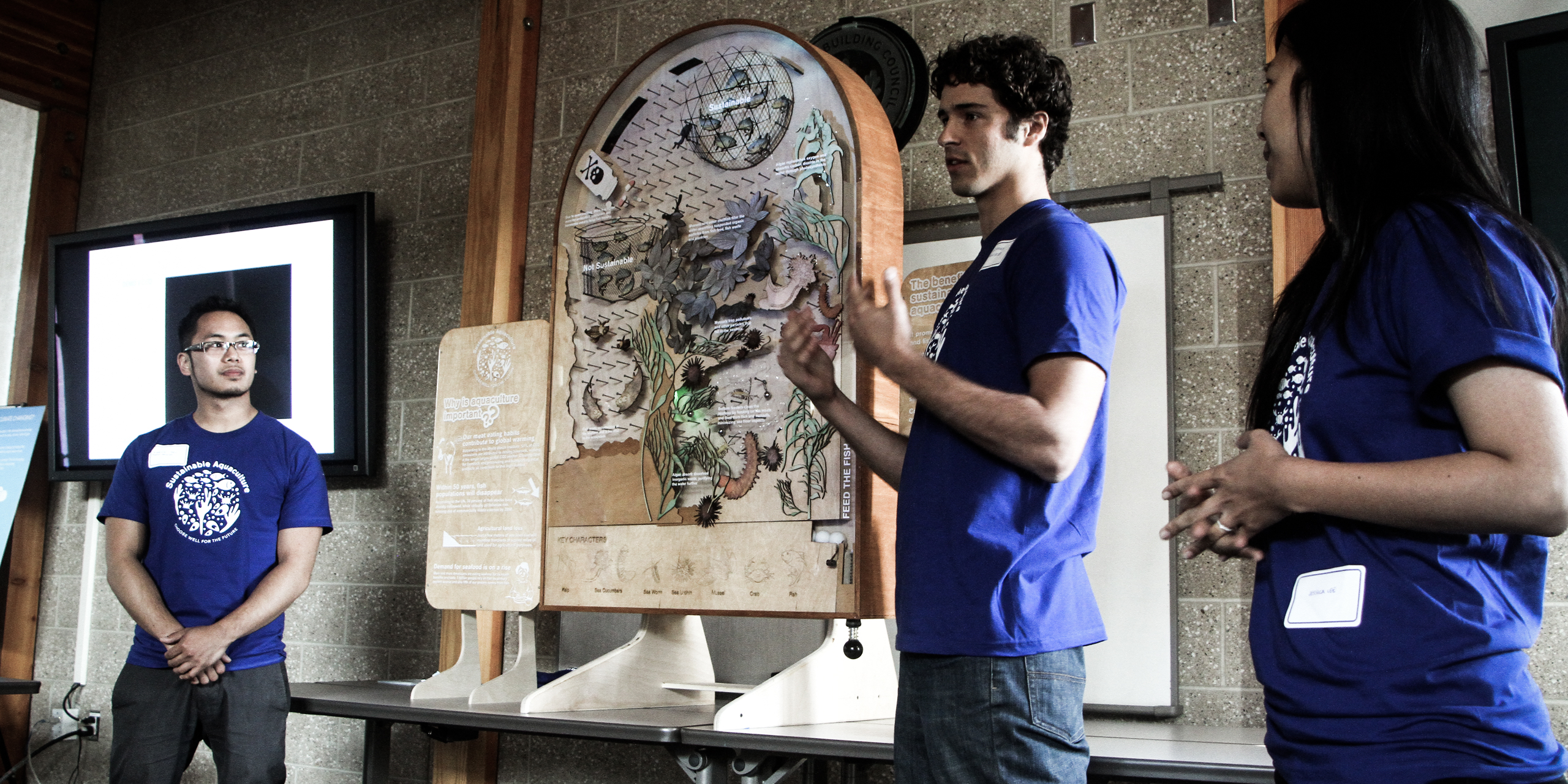
Spring 2011
Product design-led studio focusing on public education and action strategies to address the crisis of sea level rise, in partnership with the Aquarium of the Pacific.
The public is often deaf, confused or misinformed about the science of climate change and sea level rise. This has stalled a collective response to and preparation for a future that will be very different. The design challenge for students was to make this complex subject clear, relevant and compelling to people visiting the Aquarium. These designers created ‘stories’ and experiences that invite people to learn, and do something, about sea level rise.
— Heidrun Mumper-Drumm, Co-lead faculty, Aquarium Project
Design Brief
Challenge
In collaboration with the Aquarium of the Pacific, “Project Coastal Crisis” challenged students to develop educational campaign strategies and products to bring public awareness about the impact of Sea Level Rise in Southern California Coastal communities.
Designing appropriate strategies to respond to the challenge of sea level rise was the focus for “Project Coastal Crisis,” a trans-disciplinary project embedded in the “Design for Sustainability” studio of Art Center’s product design department curriculum. Students in Project Coastal Crisis were challenged to translate urgent scientific data on sea level rise and coastal resiliency into readily-accessible public awareness communications and educational tools.
About the Aquarium of the Pacific
The Aquarium of the Pacific, located in Long Beach, California, is the fourth most visited aquarium in the nation. Its mission is simple: to instill a sense of wonder, respect and stewardship for the Pacific Ocean, its inhabitants and ecosystems. Beyond its world-class animal exhibits, the Aquarium provides opportunities to delve deeper into ocean issues. It has redefined the modern aquarium. It is a community gathering place where diverse cultures and the arts are celebrated and a place where important topics concerning the relationships of humans with our planet are explored by scientists, policy-makers, and stakeholders in the search for sustainable solutions.
In May 2009, the Aquarium convened a National Conference at the Long Beach Convention Center with support in part provided by NOAA and The National Science Foundation: Ocean on the Edge: Top Ocean Issues. One of the published reports that ensued after the conference and a series of workshops that followed was entitled“Coastal Hazards, Too Many People Living Too Close To The Edge of A Rising Sea,”and explored seal level rise and inundation—the causes and consequences, the prognosis for the future and what can be done to decrease vulnerability and risk to make coastal communities more resilient. The leading work of the Aquarium in making ocean issues come alive for the public and recognizing design as an essential contributor in that effort became the point of entry for this educational collaboration with Designmatters that was supported in part by the National Oceanic and Atmospheric Administration (NOAA) Coastal Service Centers.
Background
The Earth and the ocean are warming. Sea levels have been rising since the end of the last ice age about 18,000 years ago. However, sea levels have risen and fallen throughout geologic time. The shoreline, beaches, and coastal ecosystems including wetlands, mangrove forests and barrier islands have advanced and retreated laterally with the rising and falling sea. For nearly all of human history, some 100,000 years, humans have moved with the shoreline.
But something is different now. More than half of the 6.8 billion people worldwide live near the coast. Hundreds of millions live near in low-lying coastal areas. We have built housing and infrastructure needed to support them, all at the edge of a restless sea. Over the course of the past century, sea levels have been rising at a significantly higher rate than ever before. Major contributors to sea level rise (SLR) are thermal expansion and the melting of land ice cover in the Arctic. Sea level is expected to rise somewhere between three and six feet by 2100—but it could potentially rise more than 20 feet if ice sheets in Greenland and Antarctica continue to melt at current rates. This could be catastrophic, eradicating dry land and engulfing entire communities in water.
SLR contributes to the erosion of the coasts, threatens low-lying regions and transportation portals, contaminates groundwater and crops and increases the frequency and strength of storms. While SLR is imminent and adaptation as well as mitigation strategies are necessary, steps must be taken to reduce CO2 emissions that may lessen its catastrophic impact on future generations.
Creating a sustainable future is a design problem, the most important and challenging design problem ever faced by humans. Science provides the knowledge that defines the conditions of sustainability. Technology provides tools to achieve these qualities. Art has the power to evoke emotions and move people. Design can capture and integrate the best of science, technology and art to provide a clear, compelling roadmap to a more sustainable future. It is for these reasons that the Aquarium of the Pacific, an informal science institution, has formed a partnership with Art Center College of Design.
— Jerry Schubel Ph.D., President and CEO, Aquarium of the Pacific
Research and Project Development
The project launched with a workshop briefing at the Aquarium of the Pacific with leadership from Aquarium stakeholders and led by Jerry Schubel, Aquarium President. Scientists at Scripps Institution of Oceanography, UC San Diego shared expertise and data on the global, national and regional issues around global warming and sea level rise. The class took this foundational research to further understand key issues around the current and future state of coastal resiliency and habitat restoration, the target audiences for a communications campaign, and the kinds of action-based advocacy efforts that could support the environmental work of both the Aquarium and NOAA.
Most of the student teams focused on the scientific data that modeled implications for SLR scenarios 50 to 100 years out in coastal communities in California. They explored environmental as well as socio-economic factors that would impact how communities and policy makers would “adapt to a new normal.” They also reviewed carefully what had been the most successful strategies the Aquarium had already used to communicate to the public.
Week 4 saw a review and presentation of student research with the Aquarium team, and a midterm review of concepts in development was held at the Aquarium in early March, coinciding with the Ted2011 conference in Long Beach. The final presentation to stakeholders was held in April at the Aquarium.
Projects like these are about educating you not by force, but by engagement. These projects have touch points that linger long after the experience is over.
— Karen Hofmann, Chair, Product Design Department
Outcomes
Students formed four different teams, each producing mixed media communication strategies to educate Aquarium of the Pacific visitors and other target audiences, including California coastal communities and policymakers. Careful consideration was taken to ensure that the campaigns would be easily accessible to a wide audience. The four teams and their outcomes are outlined below.
Project Solutions
 close
close
Our Rising Seas
Read more
This team focused its efforts on the group most likely to be impacted by SLR: children.Children are most likely to be impacted by sea level rise, and they are also most likely to create life-long habits that are eco-friendly. This interactive exhibit was created to be a lighthearted and fun experience for children, and to push forward the primary message that small actions can—and do—make a difference. For example, sliding “wave-like” panels and an interactive “greenhouse gas” wall reveal facts and information, while a game of hopscotch teaches about sea level rise. Telescopes show what at-risk cities—Long Beach, San Francisco, New York and Atlanta—might look like in the future, and participants can take a shower test to learn how to prevent wasting water. A game of limbo with a pole shaped like a wave between two cities illustrates how much work must go into making sea level lower, while a character created for the exhibit, Seymour, teaches children adaptation strategies for communities living near the shore. The exhibit includes a takeaway booklet and stamps called I Commit to Make a Difference, featuring fun-to-achieve action steps children can take every day. Children not only have a great day at the Aquarium, but they are encouraged and empowered to take action from this day forward.
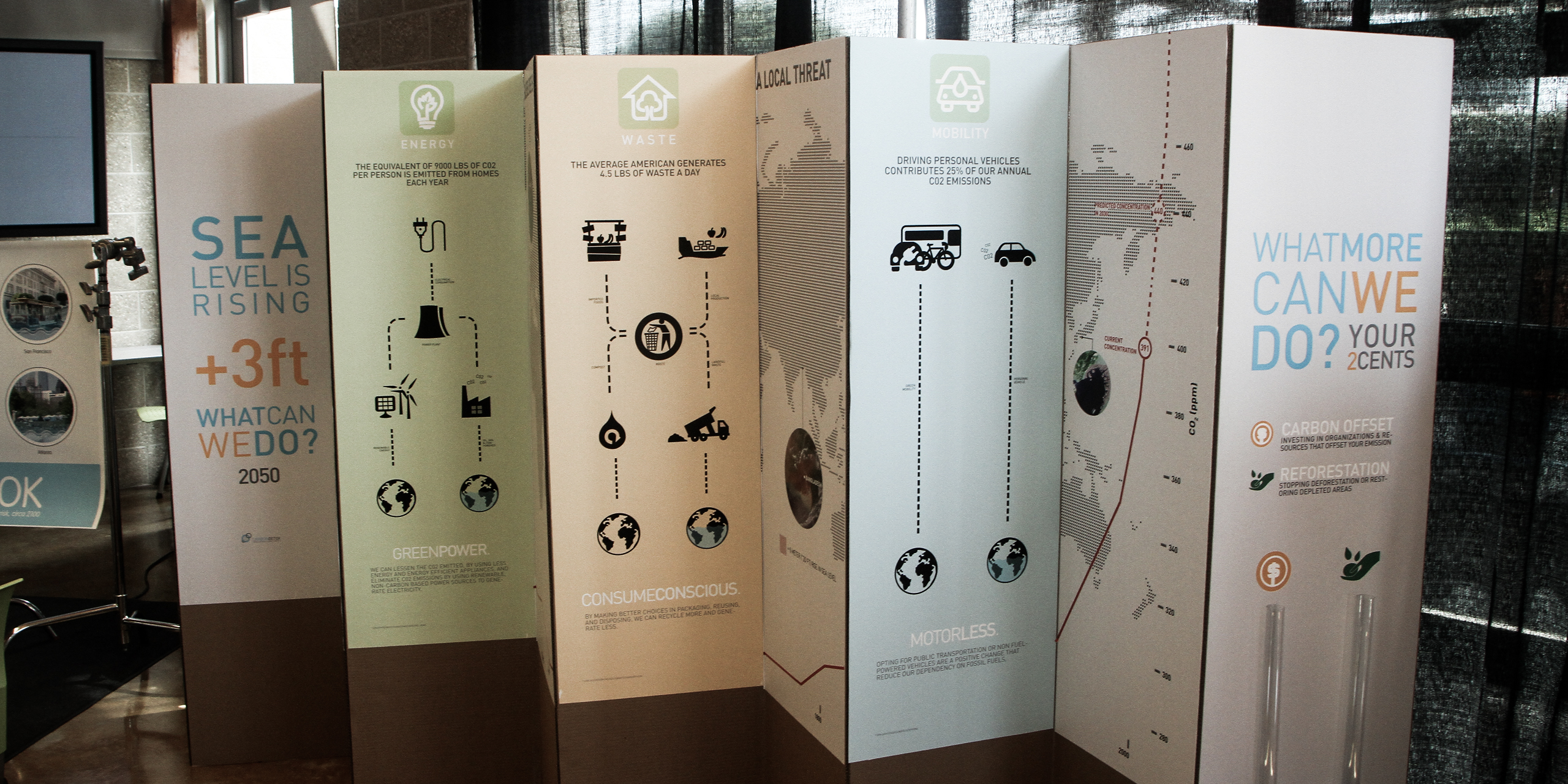 close
close
Carbon Detox
Read more
This team began by framing the problem for the general public: Where are we now? Where do we need to be? And where are we headed? Beyond public education, the campaign aims to push the reality that our future will be impacted by sea level rise—it’s not if, but when. All concepts were conceived to be economically sound, versatile and low-tech. An accordion pop-up exhibit is designed to feature climate change mitigation strategies, while an interactive table, placed in the high- traffic café area—is intended to spark education and dialogue while visitors eat and relax. The table features a futuristic United States map, customized with missing key pieces of the coast as a result of sea level rise. Magnetic sand underneath the tabletop is reactive to magnetic salt and pepper shakers, allowing users to physically add land back to the map, thereby metaphorically taking action to mitigate sea level rise. Napkins with messaging and tips (drive less, conserve energy, be consumer conscious) serve as consumer takeaways.
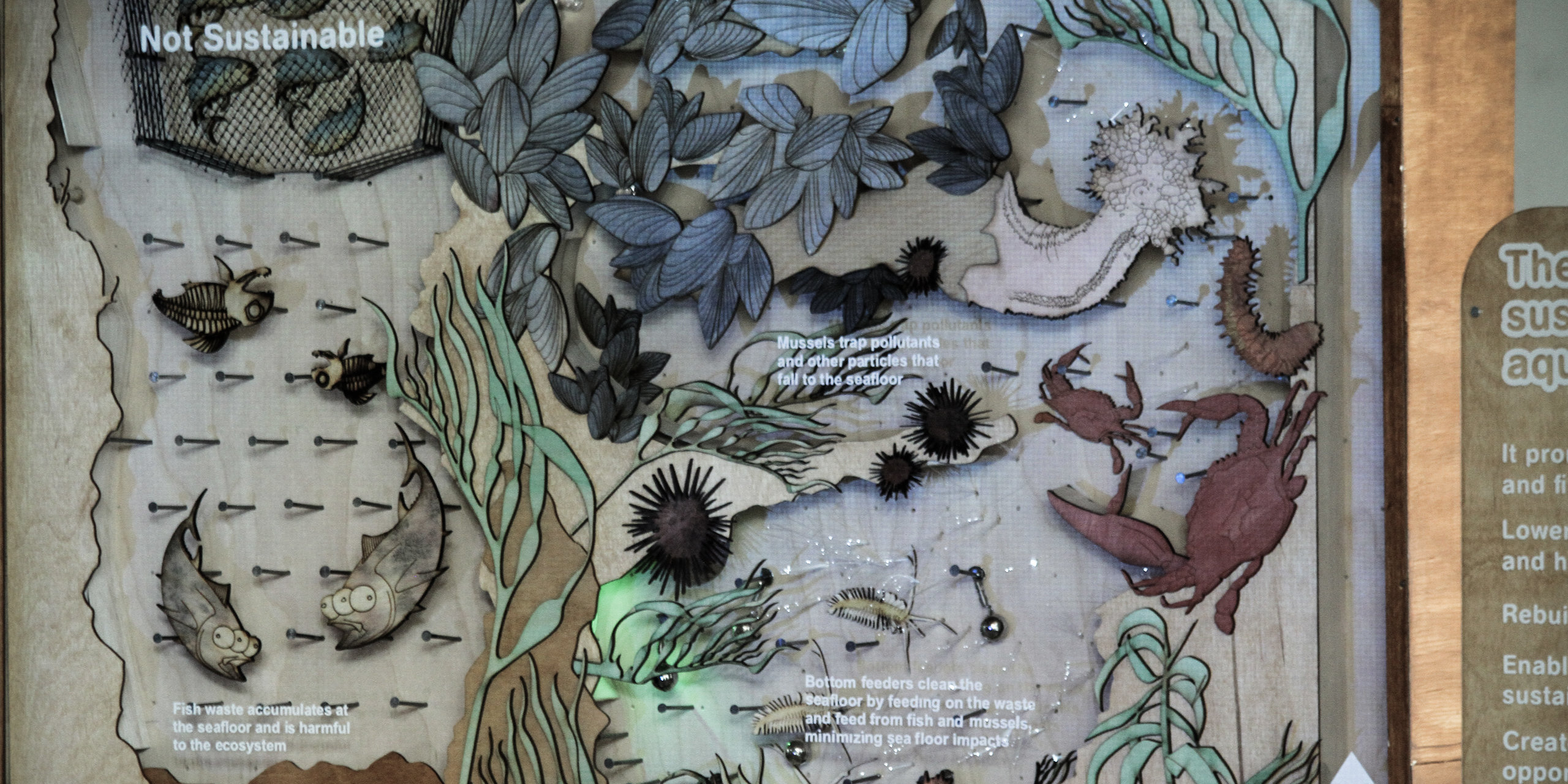 close
close
Sustainable Aquaculture
Read more
Choose Well for the Future: This team designed a complementary piece to the exhibit with the goal of representing the benefits of aquaculture and its role in addressing climate change and SLR. Messaging was created around the importance of aquaculture and its benefits. Benefits of this system include reduced emission of methane by substituting for meat-based diets more fish-based proteins, while developing healthy marine ecosystems and a sustainable form of food production to replace agricultural areas lost to sea level rise. The pinball game was designed to reaffirm these messages by releasing a ball, which represents nutrients. Players aim it toward the “sustainable” side of the game board—a difficult feat. The nutrient balls then tumble through multiple “eco-systems,” which cycle the “nutrients” for downstream systems. The rewards of multi-trophic aquaculture are represented as the “nutrients” travel through the sustainable side of the board with bells and lights that signify the benefits of a balanced, non-toxic, biological cycle of food production. Conversely, unsustainable fish farming is represented by the one-way flow of “nutrients” and chemicals through one, fish-specific “eco-system,” with increasing build up of “toxins.” Nutrient balls traveling through the unsustainable system are greeted with buzzers and error lights as the balls collect and build up on the sea floor. Exhibit takeaways include postcards and petitions supporting integrated multi- trophic aquaculture to send to local legislators
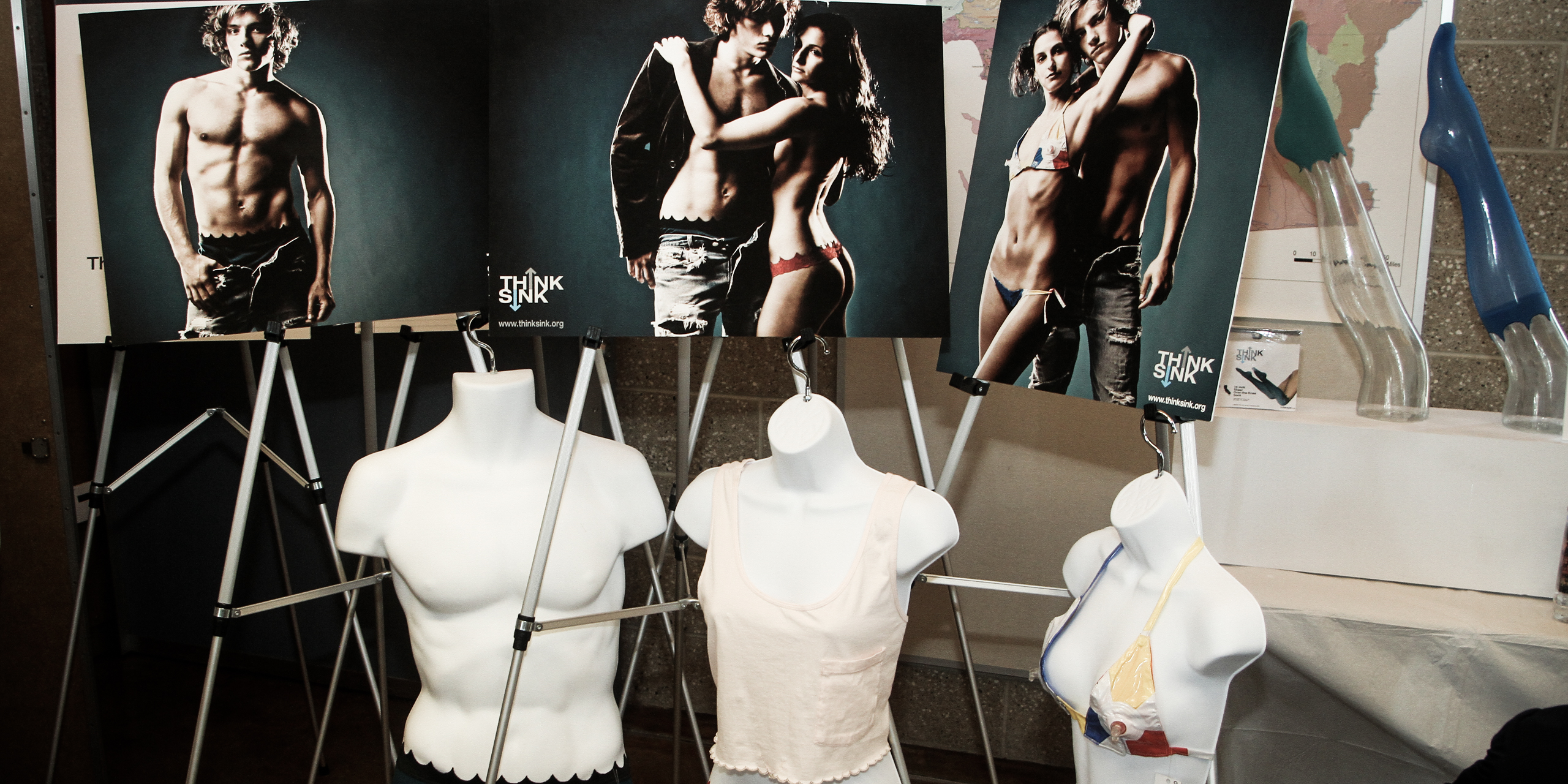 close
close
Think Sink
Read more
The goal of the Think Sink campaign is to raise awareness through humor, to encourage audiences to decrease carbon emissions, and to garner public support to implement policy change around the issues. Think Sink takes a deliberately fun and light-hearted approach, encouraging interest while disseminating key information around critical issues. Ready-to-market products include: reusable coffee cups and “float pens” that cleverly visualize rising sea levels in cities like Los Angeles; Sea Level Socks, Boxers and Panties with “rising wave” designs of various levels meant to be visible on the body; the Sea Level Rise Bikini, which can be inflated and used in a sea level rise emergency; and others. The clothing and product lines developed around Think Sink, although whimsical, share a common goal of driving traffic to the campaign website—envisioned as a space to catalyze a grassroots movement around mitigation and adaptation. After viewing the exhibition, viewers are directed to a ThinkSink website where they can sign a petition urging mitigation and adaptation responses from governing bodies.
Next Steps
Designmatters developed an informational brochure highlighting the key proposals from the class. The project proposals are currently under review with project partners and a careful assessment will determine which concepts go forward onto an implementation phase.
The projects were also on exhibition at The NASA/Jet Propulsion Laboratory August 25 – September 1, 2011 and will be on display again Saturday, November 12, 2011 for the JPL Climate Change Symposium.
Brochure
-

-
Aquarium of the Pacific Brochure
Download PDF
Videos: Project Solutions
Project Publicity
-
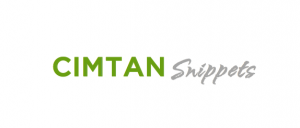
-
CIMTAN Snippets Newsletter (Feb 2012)
Download PDF
